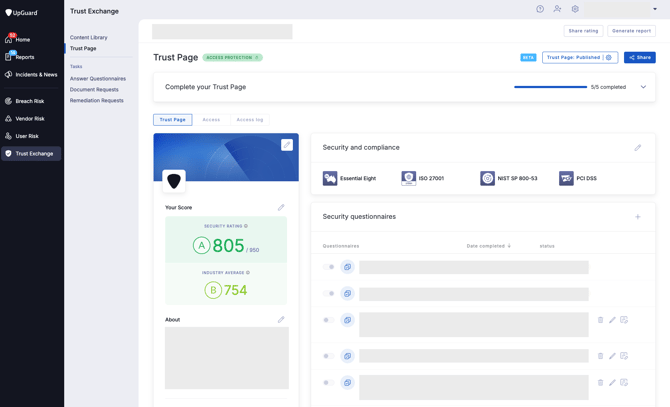Trust Pages: Overview
Trust Pages
- Are a simple and secure way to publish information about your security posture and compliance, and share it with your prospects and customers.
- Allow you to build trust and show that your organization is taking cybersecurity seriously.
- Help you spend less time filling out security questionnaires and fielding requests for security policies and compliance documentation.

Multiple Trust Pages
Trust Exchange users on free accounts can publish one Trust Page; users on paid Trust Exchange accounts can publish up to five Trust Pages.If you are a single company with multiple, distinct product lines, we recommend publishing one Trust Page per product line. Doing this enables you to share unique security information relevant to each product line, making it easier for your customers and prospects to get the information they actually need.
Trust Page launch steps
Creating and publishing a Trust Page is a quick and easy way to proactively and securely share your security posture and related documentation.
- Step 1: Customize a Trust Page
- Step 2: Publish your Trust Page
- Step 3: Share your Trust Page
- Step 4: Manage access and subscribers
What can you share on a Trust Page?
Communicate the following information on Trust Pages:
-
Security ratings: Security ratings are an evaluation of the external security posture of your publicly accessible assets. Including your security rating highlights your security posture.
-
Security contact: Share contact information for your security representative, such as your Chief Information Security Officer (CISO) or Chief Technology Officer (CTO).
- Company description, logo and cover image: Customize Trust Pages to represent your company by adding a logo, cover image, and a short description to help users understand the service your company provides.
- Compliance badges: Select the compliance badges you want to display.
-
Security questionnaires: Save completed security questionnaires to Trust Pages, which can reduce assessment time for your business partners.
-
Security documentation: You can also provide other documentation, such as compliance certifications (for example: PCI DSS, SOC 2, ISO 27001) and business-specific materials. Providing this information through Trust Pages in UpGuard ensures that your partners have the materials necessary to move forward with you.
-
Privacy and security pages: Add links to other related pages, such as your privacy policy or sub-processors page.
You can invite anyone to view a published Trust Page, and configure access and NDA settings for your Trust Center as a whole to ensure appropriate protections are in place. Users on a paid Trust Exchange plan can also set custom domains and watermarks for Trust Pages.
See also:
